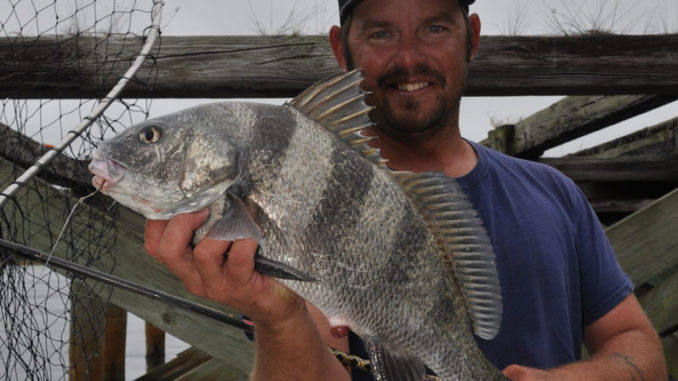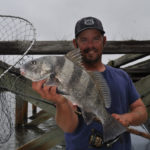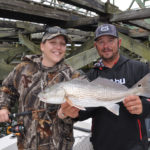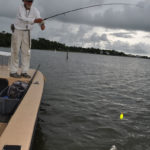
Red and black drum make for a great inshore combination for inshore anglers in the Surf City area, especially around bridges between the mainland and the beaches.
When most people smack their lips thinking about a recipe for blackened fish, red drum most often spring to mind. But anglers who fish the waters in and around Surf City are as likely to run across of another color.
“Black drum are as tasty as red drum,” said guide Wayne Crisco, who fishes along the Intracoastal Waterway around Surf City, Sneads Ferry and North Topsail Beach. “You can catch more of them to take home, but I will take either one.
“When I really want to get on fish, I head for bridges,” he said. “Several are easily reachable from Surf City. Two bridges cross the ICW near Surf City and another one is at Sneads Ferry, but any bridge is going to hold fish.”
Crisco uses basic rigs to catch fish, especially the reliable bottom rig. Call it a fish-finder rig, flounder rig or Carolina rig, it has a leader with a hook and swivel and an egg sinker sliding on the line above the swivel.
“I usually use a silver Kahle hook, but a wide-gap or circle hook works. It’s more important to put the bait in the right spot and to choose the right bait for the fish you want to catch.”
The best bait for most species is shrimp. Crisco buys fresh or frozen shrimp at a bait and tackle shop.
“I just hook the entire shrimp and cast it,” he said. “When you are fishing bridges, a cast might be an underhand lob.”
Crisco demonstrated that casting can also mean poking his rod tip through the bridge structure and flipping the rig like a bass or crappie angler tossing a jig under a boat dock. When the bait hit bottom, he turned the reel handle to take slack out of the line. Then he held the rod, waiting for a bite. The rod tip twitched, and he set the hook.
“This feels like a good fish,” he said. “The way it is running, it is probably a black drum.”
Deftly, Crisco moved his rod from one hand to another, pulling the fish away as it attempted to wrap the line around a piling. The 15-pound braid held as it scraped against the concrete, and he eventually worked the fish away from the piling to scoop it from the water with a net.
Cristina Asbury, who was fishing with Crisco, dropped her rig alongside the piling, and it wasn’t long before she set the hook and began working a fish away from the piling.
“It’s a red drum,” Crisco said. “Just keep the rod tip away from the structure and keep the pressure on the fish.”
Those two species represent the majority of what most anglers catch when fishing the bridges, docks and seawalls around Surf City, but flounder, sheepshead and spadefish are other possibilities.
“If you want to catch red drum and flounder, you might want to stick with live or cut mullet,” Crisco said, “but if it is sheepshead and black drum you’re after, the best baits are crustaceans. The easiest to get is shrimp, but those fish also bite fiddler crabs and clams. Any bait you use is going to attract pinfish, pigfish and other bait stealers. The only thing you can do is to fish where they are not. The bait stealers are usually not as bad when the water flow is strongest.”
Lee Parsons is another guide who fishes the area, and he fishes around the bridges, too, but he is more-often fishing the bays around Topsail Island, Surf City and New River, where he scans the water from the bow of his skiff.
“You have to know the tide times of the various areas to find the fish,” he said. “Some of the areas I fish are flats where there is little to no water to float a boat at low tide. But those same places have a bounty of fish when the tide covers them.”
Parsons catches red drum, black drum, flounder and other species using the same types of bottom rigs that Crisco uses. He also baits them with shrimp and mullet.
“I find a place along a shoreline with some type of anomaly that attracts fish,” he said. “It may be an old bulkhead or dock, or it can be just a tiny creek or ditch entering a larger bay. At the ditch mouths, the best time to fish is falling tide.”
Parsons also looks for crab pots, stakes that commercial fishermen have poked into the bottom to mark channel edges or obstructions and natural drop-offs. The prime structure he looks for that covers the largest amount of area is natural oyster beds.
“Oyster beds attract a lot of different fish and can cover acres,” he said. “The only ways to find out if a certain oyster bed or other structure holds fish is to actually see the fish or work the area until you start catching them.”
By using his trolling motor or poling, Parsons moves his boat along slowly. He may not cover more than 200 yards in a half day of fishing. He uses polarized glasses to cut glare when he is staring down into the water.
“If you startle a fish, you can usually tell what it is by the wake it makes or by its mud trail,” he said. “A ray leaves a different type of mud trail than a flounder. A red drum makes a different wake than a black drum. A school of large mullet can fool you with their wakes until you see enough of them so you can tell what you are looking at.”
While a bottom rig can snag, resulting in a cut-off leader on an oyster bed or on some other underwater obstructions covered with shells, a float rig seldom snags. He uses a very short leader on his float rigs to keep the bait above the shells.
“My favorite bait for catching red drum on a float rig is a mullet head,” he said. “The head is durable and won’t come off after multiple casts, and the red drum just seem to like it best. I might catch a black drum or flounder but am more likely catch is a red drum.”
Fishing an area of marsh, Parsons lobbed a cast about 40 feet from the shoreline, allowing the bait to dangle over an oyster bed.
“In this area, the fish have been out a good way from the bank the last several times I fished,” he said. “The fish also prefer different retrieves on different days. I keep experimenting to see what works best. Recently, the fish have been a little picky. I make a cast and allow the bait to settle beneath the float. Then, I let it sit.”
After a minute or so, he gave one small tug on the line with his rod tip. Taking up the slack, he allowed the bait to settle before tugging the line again. A couple of minutes later, he saw a wake made by a fish charging the bait. He waited until the fish struck the bait and hauled the float underwater.
“That’s him,” he said. “It feels like a good red drum.”
Moments later, he landed the red drum, which was about 26 inches long. He released the fish and poled a few yards further before making another cast. Repeating the process, he landed a half-dozen red drum in less than an hour.
“These days it seems everyone has forgotten how to cover water,” he said. “They run over fish to get to fish, making them spookier in the process. If you find a good spot, the best thing to do is fish it slowly and thoroughly before moving on to try another one. I can spend an entire day fishing one or two spots and catch more fish than someone who runs and guns from place to place if for no other reason than my bait is in the water longer.”
DESTINATION INFORMATION
HOW TO GET THERE — Surf City lies between Topsail Beach and North Topsail Beach along the boundary between Pender and Onslow counties. Best access is via US 17 and NC 210 and NC 50. Popular boat access areas include Turkey Creek, on Turkey Point Road, Holly Ridge, and Hampstead, off Lewis Road in Hampstead. Surf City ramp, on the east side of NC 210 bridge, will close May 5 for renovations.
WHEN TO GO — May and June are peak months for catching red drum, black drum, sheepshead, spadefish and flounder.
BEST TECHNIQUES — Shrimp, mullet, fiddler crabs and clams fished on bottom rigs are tough to beat, along with mullet and shrimp fished on float rigs. Try MirrOlure Top Dogs for red drum on the flats.
FISHING INFO/GUIDES — Capt. Wayne Crisco, Last Resort Charters, 910-465-0611. Capt. Lee Parsons, Gotta Fly Guide Service, 910-540-2464. See also Guides and Charters in Classifieds.
ACCOMMODATIONS — Sea Scape Motel, Surf City, 910-328-5881; Island Inn, Surf City, 910-328-2341; Surf City Welcome and Visitors Center, Surf City, 910-328-2716.
MAPS — Capt. Segull’s Nautical Charts, 888-473-4855, captainsegullcharts.com; Sealake Fishing Guides, 800-411-0185, thegoodspots.com.




